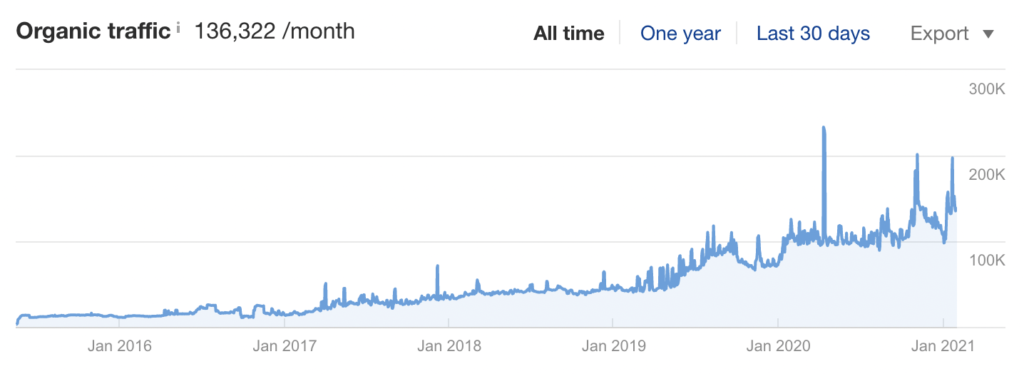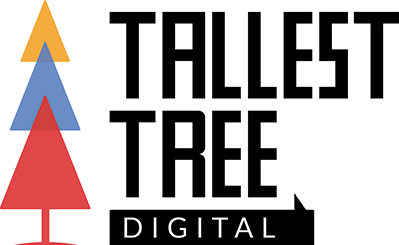Think tanks have been early adopters of many modern marketing methods, but our study of 308 US think tanks shows that some think tanks achieve outsized search engine results when compared to their headcount and annual budget.
These groups have one things in common: they treat their websites like an asset to be managed. They understand what we call “The Library Model.”
The Library Model takes advantage of compounding growth, just like an investment portfolio. This approach turns short-term PR wins into long-term search engine traffic returns, allowing the high-performing groups we’ve highlighted below to grow their organic search traffic by as much as 60% per year.
That’s an incredible force multiplier in the war of ideas.
Any think tank can adopt The Library Model. It’s not something that requires you to throw out your current way of doing things. Instead, it’s about using the traffic and data your websites produces to make your existing PR process more powerful and a bit better informed about your audience.
To understand this new model, let’s talk about the old model, inherited from the world of print media, that’s holding too many groups back.
The Publication Model
Traditionally, the PR model at think tanks centered around publications. Researchers generated a report or study and then the communications or government relations departments did the PR work.
An event was held, newsletters were mailed, op-eds breaking down the research were written, and media appearances were booked whenever possible.
With the advent of “new media” these things were replaced with faster, cheaper, and sometimes better digital equivalents. Streamed and virtual events, email newsletters, guest blog posts, YouTube videos, and podcasts, fit neatly into the existing model.
For a while, social media added a multiplier effect, but over the years that’s been diminished as platforms squeezed organic reach in favor of a pay-to-play model.
These new media analogs of the old channels reduce costs, expand reach to a global online audience, and open up the policy conversation to a wider audience, but the PR methods remain largely the same. Everything centers around a self-contained, topical publication, usually with a limited shelf life.
Under the publication model, the battle for ideas starts anew every day. If the PR mechanisms were ever to shut down, so would the attention the think tank receives. Every citation, every mention, and every click is earned through sweat of the PR staffer’s brow.
The Library Model
Some think tanks have recognized that new media hasn’t just ushered in a world of faster, better, cheaper equivalents of the old model.
Instead, it created an entirely different, parallel system: search.
In this model, the PR professional doesn’t find an audience; instead, the audience finds you.
And that audience is seeking out that content every day, at all hours, without end. Google serves up a stunning 5.6 billion search results every day. Search has become so ubiquitous, it’s easy to forget how much we use it. We’re so saturated in web searches, we’ve become like a like fish who doesn’t know it’s wet.
Though we can’t know all the complexities of Google’s proprietary algorithm, we do know it tends to favor heavily cited, long-form, in-depth work that has lasting value.
This means that think tanks, more than nearly any other content producer, are poised to take advantage of search and the long-term recurring traffic generation of The Library Model.
Tomasz Tunguz, Venture Capitalist at Redpoint, calls this approach “compounding content marketing” and illustrates its effects with this chart:

In this example, an initial piece of content is published, gains some views, and then it’s traffic diminishes over time, but not completely. The next publications or post is then added on top of the last one. By the end of twelve months, these well-positioned web pages are generated 200,000 views per month.
To further add to this compounding affect, every time that a new domain links to your website, it gains domain authority, possibly the most important ranking factor in search results. So links to new posts help older posts in search. New content doesn’t bury or obscure the old content, it makes it more visible and more likely to be found.
So, under the library model, each day builds on the last and the whole of your content becomes greater than the sum of its parts. The PR team’s efforts aren’t just earning today’s traffic, they’re building links to valuable content that will drive traffic, next week, next month, and next year through search.
Who’s Winning the Compound Growth Game?
This idea of compounding growth isn’t theoretical. We can point to example after example in the think tanks we’ve studied who make shockingly effective use of The Library Method.
Prison Policy Initiative
Prison Policy Initiative has seen organic traffic grow from 15,000 visits/month in 2015 to over 60,000 in 2020. That’s an annual growth rate of over 30%.

We highlighted their Mass Incarceration: The Whole Pie report in our 2020 Think Tank Search Performance Ranking as an example of a “definitive report.”
This annual series has grown year by year with the latest edition attracting links from over 3,500 unique domains—more than many think tanks’ entire sites.
By increasing their site’s overall authority, this report makes the rest of the content on the site more visible in search, pushing overall monthly traffic up.
Illinois Policy Institute
Illinois Policy Institute has seen its organic traffic growth from 11,000 visits/month in 2015 to over 135,000 today. That’s an annual growth rate of over 65%.

IPI ranks for over 100,000 keywords, landing on the first page of Google for 10,000 of those. That’s what drives traffic to its recent pieces and its back catalog—incredible search visibility.
This search engine performance places IPI well ahead of many national think tanks with larger budgets and much more content.
Tax Foundation
Tax Foundation has seen its organic traffic growth from 100,000 visits/month in 2015 to over 1,000,000 today. That’s a nearly 60% annual growth rate.

Tax Foundation has achieved this huge traffic figure by breaking down complex tax policy information into user-friendly posts with simple-to-understand charts like these:
- 2020 Tax Brackets
- Congress Passes $900 Billion Coronavirus Relief Package
- What Are Payroll Taxes and Who Pays Them?
These posts don’t feature analysis or opinion. Instead, they provide a straightforward breakdown of what are otherwise inscrutable policy details. This makes for incredibly linkable content—basic facts that bloggers and journalists can cite.
The links and traffic these posts generate makes Tax Foundation’s more analytical and opinionated work more visible. The rising tide lifts all boats.
The Virtuous Cycle of PR & SEO
The traffic growth rates produced by The Library Method make Warren Buffet’s 17% annual returns look positively sluggish.
But this doesn’t mean that traditional PR isn’t needed—quite the opposite.
PR generates the initial attention for each piece of web content, driving views and generating links. Trying to build a compounding growth strategy without PR is like trying to focus on building your 401k by quitting your day job.
As illustrated in this infographic from Publicize, the relationships between PR and SEO isn’t one-sided. While PR boosts the SEO of your website, your website gathers important data that informs the work of PR.

Prospects lists can be built by creating lists of not only who linked to you, but who linked to your competitors. The popularity of pieces in your catalog, both in terms of traffic and total links, can help determine the subject or presentation of future content. Gap analysis and keyword research can reveal openings the marketplace of ideas.
All of this can help PR better plan its next move.
Managing Your Content Library Like an Investment Portfolio
We believe every think tank marketer should not only adopt The Library Method, but should also start treating their content library like an investment portfolio.
Unfortunately, many think tanks in our search performance ranking have done the digital marketing equivalent of burying their money in mason jars. Their slow, error-riddle websites are a confusing mess to Google, so their content isn’t yielding much of a return.
Others don’t have these technical problems, but they aren’t actively managing their content either. Without actively responding to the market signals that your website and modern SEO tools can provide, this is like buying treasury bonds. Sure, you’re earning interest, but still losing value.
Instead of taking the mason jar or t-bills approach, we recommend thinking like an active investor. Think tanks should be rehabilitating their distressed assets and looking for future value buys. They know the policy market better than anyone and they should put that market knowledge to work and earn a great return.
In other words, you should always be looking for ways to get more performance out of the content you have and establishing methods for creating new content that will draw in search traffic in the future.
We break this down in the Search Engine Optimization section of this knowledge base.
Turning Traffic into Audience & Impact
The rest of this knowledge base tells you how to capitalize on your combined PR + SEO traffic generation. We break down those methods into three additional fields within content marketing:
User Experience
This discipline can often be shrouded in pseudo-psychological talk, but we think it’s pretty straight-forward. It’s about getting from point A to point B without getting frustrated along the way. Sure, that requires getting about 300 things right, but we wrote a list, so we’ve got this.
Getting UX right means increasing user engagement and converting visitors into subscribers and regular promoters of your work.
We can show you how to improve your site’s UX today, no coding required.
Content Strategy
We want to help think tanks break out of the blog mentality of featuring new stuff at the top of the list, and older stuff at the bottom. That’s Publication Model thinking and won’t get you the best results.
Structuring your content to serve specific purposes for specific audience is a much better approach.
A good content strategy will help build intangibles, like brand value, while bolstering your SEO and usability.
Start with your content, we’ll show you how.
Software Architecture
Most web design companies put this first. They think the latest JavaScript libraries or approach to databases is what makes a website good or bad.
We take a different view.
We value building solid, standards-compliant software not for its own sake, but because it ensures that your content marketing engine never stalls out due to some glitch that could have been avoided.
Keeping your software development as modular possible isn’t just about performance or efficiency, it’s about reducing risk and controlling costs for you, the customer. Your website should be as low-cost, simple to maintain, and easy to change when necessary. That’s why quality code matters.
We break this down into guidelines a non-technical audience can understand.


